 klaus-michael schneider
klaus-michael schneider
Keywords: education |
Links: FOTW homepage | search | disclaimer and copyright | write us | mirrors

FOTW beschäftigt sich mit der Wissenschaft der Vexillologie (Flaggenkunde).
Alle auf dieser Website dargebotenen Abbildungen dienen ausschließlich der Informationsvermittlung im Sinne der Flaggenkunde.
Wir distanziert uns ausdrücklich von allen hierauf dargestellten Symbolen verfassungsfeindlicher Organisationen.
Last modified: 2021-08-26 by  klaus-michael schneider
klaus-michael schneider
Keywords: education |
Links: FOTW homepage |
search |
disclaimer and copyright |
write us |
mirrors
See also:
Other Institutions:
 image by Ivan Sache, 28 January 2009
image by Ivan Sache, 28 January 2009
"Colegio La Toscana" is located in the borough of La
Toscana, ward of Suba, in the north-westernmost part of Bogotá.
Classes started on 19 April 1996.
The flag of the institute, as described on the website of the
institute, is horizontally divided white-dark red (lit.
"red wine"). The flag was adopted after a students'
competition.
Ivan Sache, 28 January 2009
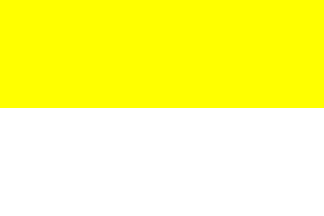 image by Ivan Sache, 27 February 2006
image by Ivan Sache, 27 February 2006
Colegio La Trinidad (Institución Educativa Rural La Trinidad)
is located in the village of La Trinidad, Municipality
of Manizales, Department of Caldas. The flag of the Colegio is
horizontally divided yellow-white. Yellow represents work, effort
and commitment, whereas white represents purity. Yellow (border)
and white (field) are also the colours of the shield of the
Colegio.
Source: <www.comunidad.com.co>,
located by Valentin Poposki.
Ivan Sache, 27 February 2006
 image by Ivan Sache, 11 September 2014
image by Ivan Sache, 11 September 2014
Colegio León XIII was established in El Peñol by Municipal Agreement No. 17,
adopted in May 1912. Unidad Educativa León XIII was established by Departmental
Decree No. 334 of 10 March 1983, as the merger of Liceo León XIII, Escuela
Urbana José Obed Hincapié, and Escuela Urbana Ramón María Giraldo. The institute
is named for Pope Leo XIII (1878-1903).
The flag of the institute is a parallelogram of 1.60 m in length and 1.10 m in
height. It has a green background and is crossed from the upper left to the
lower right part by three stripes, each of 5 cm in
width; the central stripe is red while the two outer stripes are yellow.
Green represents emerald, hope, abundance, and liberty. Red represents ruby and
fire, valor, audacity, an intrepidness. Yellow represents topaz, the sun,
wealth, force, faith, and constancy.
Source:
http://leonxiii.jimdo.com/institucional/horizonte-institucional/bandera/ -
Institute's website
Ivan Sache, 11 September 2014
Colegio León XIII was established in El Peñol (Antioquia Department) in May
1912, upon request of Antonio José Díaz, parish priest since 1909. The institute
was renamed Liceo Departamental León XIII by Ordinance No. 18 of 28 December
1967, placing it under departmental administration although it remained property
of the municipality. Unidad Educativa León XIII was established by Decree No.
334 of 10 March 1983 as the merger of Liceo León XIII, Escuela José Obed
Hincapié and Escuela Ramón María Giraldo. The institute is named for Pope Leo
XIII (1810-1903, elected in 1878).
The flag of the institute is described in Chapter 3.2 of the institute's
Etiquette Guidebook. The flag, of dimensions 1.10 m x 1. 60 m, is green with
three yellow, red and yellow stripes, each of 5 cm in width, running from the
upper left to the lower right corner. Green is a symbol of emerald, hope,
abundance and liberty. Yellow is a symbol of topaz, sun, wealth, force, faith
and constancy. Red is a symbol of ruby, fire, value, audacity and intrepidness.
Source:
http://ie-leonxiii.edu.co/images/leonxiii/informacion-institucional/MANUAL-DE-CONVIVENCIA-LEONXIII.pdf
- Institute's website
Ivan Sache, 21 November 2014
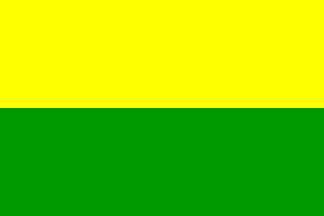 image by Ivan Sache, 3 January 2021
image by Ivan Sache, 3 January 2021
Liceo León de Greiff was established in 1977 in Cereté (Córdoba) by Esteban
López Doria and Ana Carmela Gómez.
The school is named for the poet León de
Greiff (1895-1976), founder in 1915 of the Los Panidas movement that rejuvenated
Colombian literature.
The flag of Liceo León de Greiff is horizontally
divided white-blue with the school's emblem in the center.
Photos
https://leondegreiffcerete.edu.co/index.php/noticias/248-estudiantes-lilegristas-entre-los-mejores
Ivan Sache, 3 January 2021
 image by Ivan Sache, 03 October 2014
image by Ivan Sache, 03 October 2014
Institución Educativa Instituto La Unión (ILAU) was established in La Unión
(Sucre Department) by Resolutions No. 685 of 8 November 2002 and No. 2,599 of 8
November 2003, as the merger of Instituto La Unión (est. by Departmental
Ordinance No. 72 of 26 November 1972), Escuela Santander, and Escuela Santo
Domingo.
The flag of ILAU is horizontally divided yellow-green.
Source:
http://www.ilau.edu.co/simbolos.html - Institute's website
Ivan Sache, 03 October 2014
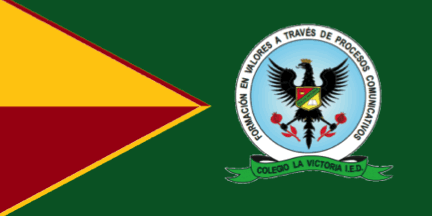 image by Ivan Sache, 18 October 2018
image by Ivan Sache, 18 October 2018
Institución Educativa Distrital La Victoria was established in October 1961
in San Cristóbal, boroughs La Victoria and la Colmena, Bogotá.
The flag
of IED La Victoria is green with a triangle horizontally divided yellow-red
placed along the hoist, with a countercolored border, and the school's emblem at
fly.
http://cedlavictoria.edu.co/institucional/identificacion/
IED La
Victoria website
Ivan Sache, 18 October 2018
 image by Ivan Sache, 22 October 2014
image by Ivan Sache, 22 October 2014
Colegio Diocesano Laura Montoya is located in Chigorodó (Department of
Antioquia). The institute is named for St. Laura of Saint Catherine of Siena
(Laura de Jesús Montoya y Upegui, 1874-1949; the first Colombian-born
saint, canonized on 12 May 2013 by Pope Francis), a nun who struggled against
racial discrimination and founded in 1914 the Congregation of Missionary Sisters
of Immaculate Mary and of Saint Catherine of Siena. The nuns affiliated to the
congregation are locally known as "Lauritas".
The flag of the institute is horizontally divided green-white-green.
Source:
http://www.diocesanolauramontoya.com/index.php/quienes/simbolos -
Institute's website
Ivan Sache, 22 October 2014
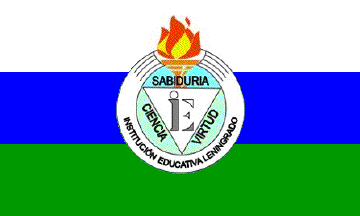 image by Ivan Sache, 16 November 2014
image by Ivan Sache, 16 November 2014
Institución Educativa Leningrado is located in Pereira (Risaralda
Department).
The flag of the institute is in dimensions 0.90 m x 1.50 m [3:5], horizontally
divided white-blue-green with the institute's emblem in the middle. White is a
symbol of innocence, peace, childhood, divinity, stability, spirituality, purity
and tenderness. It expresses the limpidity of the student's mind, the clarity of
their open mind, always prepared to receive and use knowledge. It conveys
simplicity. Blue is a symbol of confidence, reserve, harmony, affect,
friendship, loyalty and love. It expresses the deepness of intelligence;
knowledge and conscience that can be increased and transmitted from generation
to generation by giving the best of oneself as a thinking person. It is the
colour of the firmament and of the sea, symbolizing school work, merit,
spiritual and material force, as well as the infinite space where the human
being shall live (the world of knowledge, science and technology). Green is a
symbol of youth, desire, leisure, balance, freshness, vegetation and health. It
represents the hope and faith of the educationalists, who aim at educating
honest human beings. It symbolizes life and the natural environment, being the
result of the harmonic interaction human being - vegetal environment - energy -
life.
The emblem represents the unity of actions and principles in the search for
ideals (Knowledge, Science and Virtue). The emblem is surmounted by a flame,
which symbolizes the vivid feeling of love for the institute, which builds up
ideals of mutual aid. It is a symbol of knowledge and light. The flame-shaped
fire is energy, empowerment, force and dedication. The red and yellow colours of
the flame are those of the town of Pereira.
Source:
http://leningrado.edu.co/mision-vision-y-simbolos-institucionales/ -
Institute's website
Ivan Sache, 16 November 2014
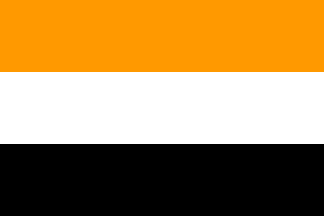 image by Ivan Sache, 08 August 2014
image by Ivan Sache, 08 August 2014
Gimnasio Cultural Libertad was established on 7 January 1969 by the Bogotá
branch of the Bavaria workers' union and acquired on 15 September 1979 by Pablo
Alejandro Casallas Jerez.
The flag of the institute is horizontally divided orange-white-black.
Source:
http://gcl.edu.co/?page_id=44 - Institute's website
Ivan Sache, 08 August 2014
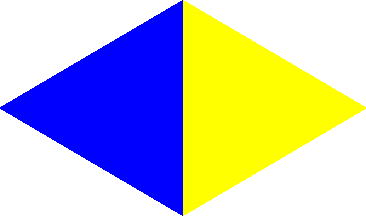 image by Peter Hans van den Muijzenberg, 16 August 2014
image by Peter Hans van den Muijzenberg, 16 August 2014
Institución Educativa Municipal Libertad was established on 10 December 1958
in Pasto (Nariño Department), as Instituto Nocturno Libertad, by the Committee
of the Economical Middle Class of Colombia, presided by Antonio José Cerón Mora.
Instituto Femenino Libertad was established on 2 October 1967. Municipal Decree
No. 351 of 28 August 2003 merged the two institutes with the Santa María
Eufrasia, Rodrigo Carvajal and Julián Buchelito schools to form Institución
Educativa Municipal Libertad.
The flag of the institute, designed by Dina
Narváez E., is white with two adjacent equilateral triangles, a blue triangle
pointing to the hoist and a yellow triangle pointing to the hoist. White is a
symbol of transparency, clarity, harmony, tolerance and peace. The triangles are
symbols of firmness and stability. Blue is a symbol of heavens and of
strong-mindedness. Yellow is a symbol of spiritual and intellectual wealth.
http://11-2jmlibertad.blogspot.fr/2012/03/institucion-educativa-municipal.html
- Institute's blog
Ivan Sache, 6 July 2014
 image by Ivan Sache, 31 January 2009
image by Ivan Sache, 31 January 2009
"Institución Educativa 'Libertador Simón
Bolívar'" was founded on 30 September 2002 in the borough
of Bolívar, Municipality of Tunja, Department of Boyacá (Decree
No. 2419), through the merging of "Colegio de Educación
Básica Simón Bolívar", "Colegio de Educación
Básica Los Libertadores" and "Concentración Escolar
del Sur".
The flag of the institute, as shown graphically and described on
the website of
the institute, is horizontally blue-white-green.
Blue symbolizes the heavens and the horizon shared by all.
White symbolizes purity and transparency.
Green symbolizes hope, the fields and the local landscape.
Ivan Sache, 31 January 2009
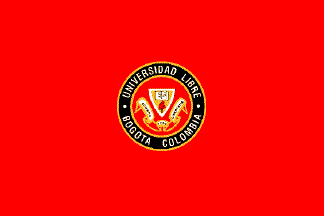 image by Ivan Sache, 28 December 2008
image by Ivan Sache, 28 December 2008
after photos on the main
website, with "Bogota" on the
emblem
 image by Ivan Sache, 28 December 2008
image by Ivan Sache, 28 December 2008
after the Cali
website, without "Bogota" on the
emblem
Image at <www.ulibrepei.edu.co>.
Dov Gutterman, 21 July 2002
According to the picture at <www.ulibrepei.edu.co>,
the seal seems smaller and towards the hoist. The description
says however that the seal is in the center.
Carlos Thompson, 17 March 2003
"Universidad Libre" succeeded on 13 April 1912
"Universidad Republicana", founded in Bogotá at the
end of the 19th century by Liberal and Masonic intellectuals.
Lacking funds, the university could not start classes until 13
February 1923, with the help of General Benjamin Herrera,
unsuccesfull candidate at the presidential election in 1921.
The university has its main seat in Bogotá and regional seats in
Baranquilla, Cali, Cartagena, Cúcuta, Pereira and Socorro.
The flag of the university, as shown on different websites of the
university, is red with the university emblem in the middle. Red
represents the academic dignity, action and permanent revolution
for freedom.
The emblem of the university is made of a red disk charged with
the shield of the university, black with a white open book
surmonting a red Phrygian cap, and a white scroll bearing the
motto of the university, "Sciencia Fons Libertatis", in
Latin, "Science source of freedom", in black letters.
The disk is surrounded by a black ring outlined in gold an
charged with the name of the university in white capital letters.
Symbols' page on the university main website is at <www.unilibre.edu.co>.
Symbols' page on the Cali seat website is at <www.unilibrecali.edu.co>.
Symbols' page on the Cúcuta website is at <www.unilibrecucuta.edu.co>.
Symbols' page on the Pereira website is at <www.unilibrepereira.edu.co>.
The best view on the flag has to be found on the Cali website.
There are a number of variations in the representation of the
emblem in these images.
Ivan Sache, 28 December 2008
 image by Ivan Sache, 28 July 2018
image by Ivan Sache, 28 July 2018
The symbols of Institución Educativa Limonar is prescribed by Agreement 16-1,
issued on 25 July 2001.
The flag, designed by the teacher María Lucy
Gaitán de Díaz, is divided yellow-green by the descending diagonal, with the
institute's emblem in the center. The colors are those of lemon ("limón"),
representing the borough and the school. The diagonal stripes represent the
projection of the students in the professional environment. The yellow field
represents the process of cognitive, communicational and ethical maturation. The
green field represents the growth stages that slowly develop during the school's
life.
The emblem was designed by Jean Fredy Cortes Medina, student in 9th
class.
https://institucionlimonar51423.jimdo.com/informaci%c3%b3n-general/
IE
Limonar website
Ivan Sache, 28 July 2018
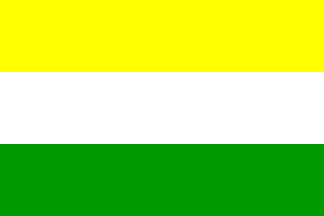 image by Ivan Sache, 27 November 2014
image by Ivan Sache, 27 November 2014
Liceo Técnico Comercial (LITECOM) was established in October 1973 in
Jamundí (Valle Department) by Guillermo Coll Salazar, Bárbara Kaina
Guerrero, Mariano Ramírez, Arnulfo Escobar, Esther Lida Rodríguez,
Humberto Vidal and Miguel Antonio Sánchez.
The flag of LITECOM is horizontally divided yellow-white-green.
Yellow is a symbol of the region's resources; this is also the proper
colour of interbreeding and of the immense cultural resources of
melting-pot.
White is a neutral colour, also the symbol of peace, meaning
tolerance, rest, openness to dialogue, and openness to shake a
friendly, sincere and cordial hand. It reflects equal participation of
all.
Green is the colour of hope; it also represents the intense greenness
of the cordilleras and mountains. Green is the colour of the coffee
plantations, of the pastures and of the horse ranches. It is the
colour of biodiversity and of a healthy and healing environment.
Source:
https://sites.google.com/site/colegiolitecom/simbolos-de-la-
institucion - LITECOM website
Ivan Sache, 27 November 2014
 image by Ivan Sache, 26 November 2014
image by Ivan Sache, 26 November 2014
Institución Educativa Comercial Litoral Pacifico was established in
Bocas de Satinga (Municipality of Olaya Herrera, Nariño Department) by
Resolution No. 2,541 of 30 September 2002.
The flag of the institute is in dimensions 1 m x 2 m, horizontally
divided white-blue.
White symbolizes peace, while blue symbolizes the sea.
Source: http://www.angelfire.com/al4/cololaya.edu.co/ - Institute's website
Ivan Sache, 26 November 2014
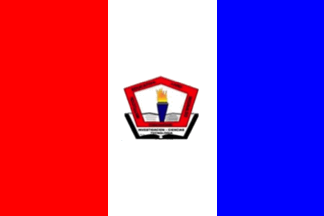 image by Ivan Sache, 26 October 2018
image by Ivan Sache, 26 October 2018
Institución Educativa Livio Reginaldo Fischione is located in Riohacha
(Guajira Department).
The school is named for His Grace Livio Reginaldo
Fischione (1925-2009), Vicar Apostolic of Riohacha (1966-1988) and Titular
Bishop of Aquae in Byzacena (1966-2009).
The flag of IE Livio Reginaldo
Fischione is vertically divided red-white-blue with the school's coat of arms in
the center.
http://livioreinaldo.blogspot.com/2009/09/actualizaciones.html
School
blog
Ivan Sache, 26 October 2018
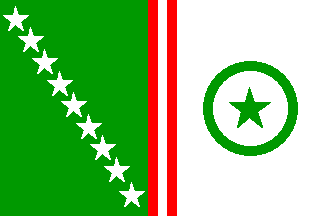 image by Ivan Sache, 14 November 2010
image by Ivan Sache, 14 November 2010
Colegio Llanadas is located in Lebrija (Department of Santander).
The flag of Colegio Lanadas, as shown graphically on the institute's website, is
vertically divided green-white, with three vertical stripes in the middle, red,
white and red, respectively. Nine white stars are placed on the descending
diagonal of the green field. A bigger, green star inscribed in a green ring is
placed in the middle of the white field. Green symbolizes the natural resources,
white symbolizes peace and
harmony, red symbolizes the blood shed during the Palonegro War*. The big green
star symbolizes the main seat of the institute, while the nine white stars
symbolize its nine rural seats.
Source:
http://cllanadas-puyana.blogspot.com/2008/09/simbolos-del-colegio.html
*The Battle of Palonegro opposed from 11 to 26 May 1900 Liberal and Conservative
troops, during the Thousand Days War (1899-1902).
Ivan Sache, 14 November 2010
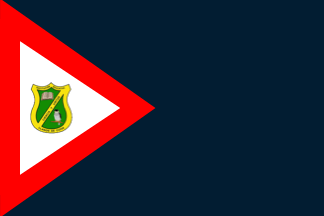 image by Ivan Sache, 10 January 2021
image by Ivan Sache, 10 January 2021
IE Llanos de Cuivá, located in Yarumal (Antioquia), originates in the
establishment of Liceo Anexo Llanos de Cuivá by Resolution No. 9,521 issued on 4
February 1976, as a dependency of IDEM de Santa Rosa de Osos. Classes started in
a room offered by parish priest Heriberto Yepes Sierra.
Concentración
Educativa Llanos de Cuivá was established by Decree No. 344 issued on 10 March
1983, as the merger of Escuela José Mejía and Liceo Anexo Llanos de Cuivá. The
school was renamed to Institución Educativa Llanos de Cuivá by Resolution No.
15,029 issued on 25 October 2002. Resolution No. 132,777 issued on 18 November
20914 incorporated La Bella, El Retiro, San Antonio and Santa Isabel schools to
IE Llanos de Cuivá.
https://iellanosdecuiva.edu.co
School website
The flag of IE
Llanos de Cuivá, designed by Teacher Martha Cecilia Areiza Torres and student
Diana Carolina Vásquez Ruiz, is blue with a white triangle bordered in red and
placed along the hoist, charged with the school's coat of arms.
Blue is a
symbol of stability, deepness, loyalty, confidence and intelligence.
Red is a
symbol of power, vitality, ambition, life, youth and energy.
White is a
symbol of purity, light, kindness, innocence, purity, optimism and perfection.
The coat of arms, designed by ex-student Juan Carlos Chavarria Mazo, is
surrounded by a yellow border and divided by a diagonal stripe running from the
lower left to the upper right part, of the same color.
Yellow is a symbol of
sunlight, intellectual resources, originality and glee, and felicity and energy.
The diagonal stripe is inscribed with the school's motto, "Science and Virtue".
The open book is a symbol of study, work and clear and sincere attitude.
The
owl is a symbol of knowledge, wisdom and culture.
https://iellanosdecuiva.edu.co/simbolos-institucionales
School website
Photo
https://corregimiento-llanos-de-cuiva.webnode.com.co/products/entrega-simbolica-de-la-bandera-de-la-institucion-educativa-a-los
Ivan Sache, 10 January 2021
Hosted by: Fanshop-Online.de und Handy-Shop.de
Tipp: Apple iPhone 12 im Shop